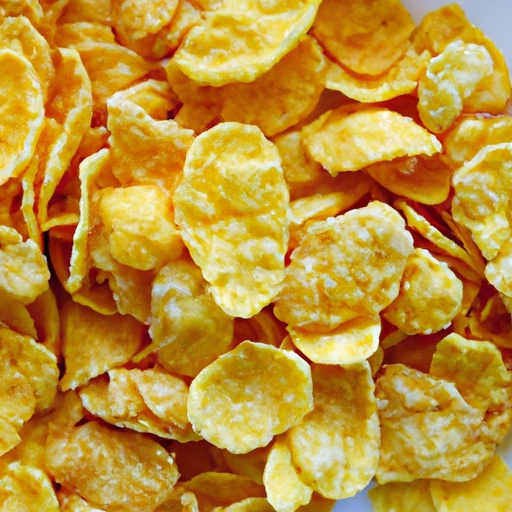Cornflake
Description

Cornflakes are a popular breakfast cereal made from toasting flakes of corn (maize). They are known for their crisp texture and light, toasted flavor. These flakes are often consumed with milk, yogurt, or fruit as a part of a quick, easy breakfast. However, cornflakes have also found their way into a variety of recipes as a crunchy ingredient or topping. With their simple preparation and long shelf-life, they are a staple in pantries across the globe, offering versatility in both sweet and savory dishes.
Common uses
Cornflakes are most commonly used as a breakfast cereal. They are also used as a crunchy coating for fried foods, as a topping for various casseroles, in breading mixes, and as a base for cereal bars, among other culinary applications.
Nutritional value
Calories
Per 1 cup (approximately 28 grams or 1 ounce), cornflakes contain about 100 calories (418 kJ).
Protein
Cornflakes provide around 2 grams of protein per 1 cup serving.
Fat
There is typically less than 1 gram of fat in a 1 cup serving of cornflakes.
Carbohydrates
A serving of cornflakes contains about 24 grams of carbohydrates, which includes less than 1 gram of dietary fiber and about 2 grams of sugar.
Vitamins
Many brands of cornflakes are fortified with vitamins, such as vitamin A, vitamin C, vitamin D, and various B vitamins, including folic acid.
Minerals
Fortified cornflakes may contain minerals like iron and calcium in varying amounts.
Health benefits
Consuming fortified cornflakes can contribute to the intake of essential vitamins and minerals. The fiber in cornflakes can aid in digestion, although they are generally low in dietary fiber. The iron content can help in preventing anemia.
Potential risks
Some brands of cornflakes can be high in added sugar, which may contribute to health problems if consumed in excess. Additionally, cornflakes are often low in fiber and may not be as filling as other breakfast options, potentially leading to overeating. People with gluten intolerance or celiac disease should avoid cornflakes unless they are specifically labeled as gluten-free, as they may contain barley malt flavoring or be subject to cross-contamination.
Common recipes
Cornflakes are used in a variety of recipes, ranging from no-bake treats like cornflake cookies and marshmallow squares to savory dishes like cornflake-crusted chicken or fish. They can also be incorporated into meatloaf mixtures, pie crusts, and homemade granola.
Cooking methods
Cornflakes are typically used as is, straight from the box, for breakfast cereals or as a topping. When used in cooking, they may be crushed and mixed with other ingredients or used as breading that is baked or fried.
Pairing with other ingredients
They pair well with milk, yogurt, and fruit for breakfast. In savory dishes, cornflakes complement the flavors of chicken, fish, and cheese particularly well.
Summary
Cornflakes are a versatile ingredient originating from the United States that have become a breakfast staple around the world. They have a variety of uses in both sweet and savory recipes and can provide nutritional benefits when fortified with vitamins and minerals. However, consumers should be mindful of added sugars and potential gluten content. Cornflakes can provide a delightful crunch to many dishes and are an essential pantry item for quick and easy meal enhancements.